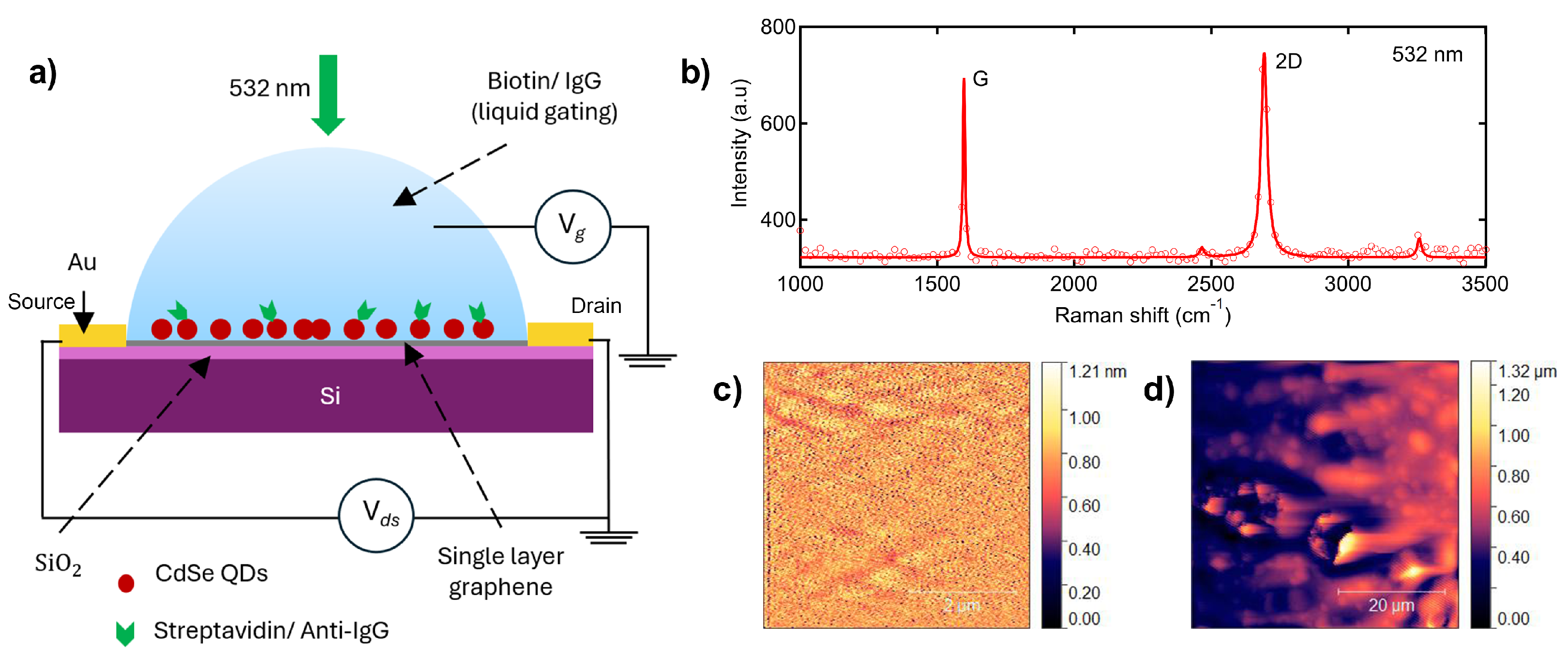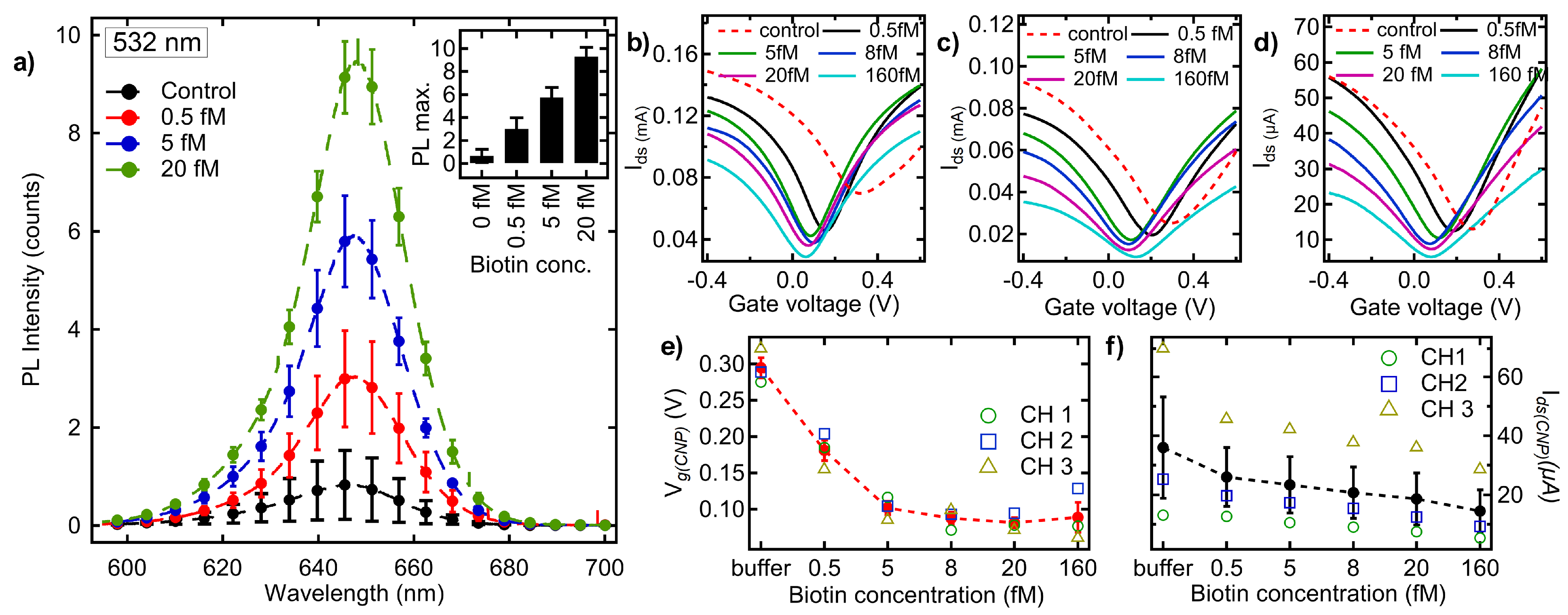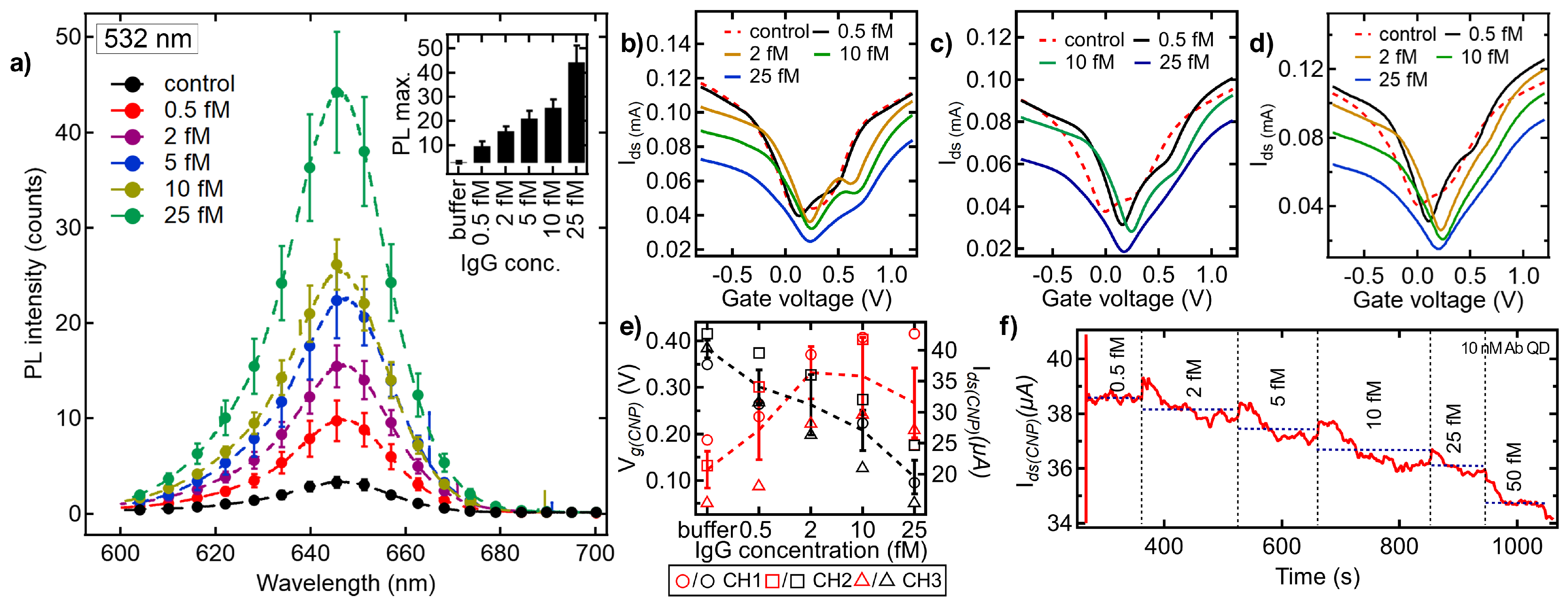Unraveling Charge Transfer Mechanisms in Graphene–Quantum Dot Hybrids for High-Sensitivity Biosensing
Abstract
:1. Introduction
2. Materials and Methods
2.1. Materials and Reagents
2.2. Raman Spectroscopy and Fluorescence Measurements
2.3. Fluorescence Microscopy
2.4. Time-Resolved Fluorescence Measurements
2.5. Electrical Measurements
3. Results
4. Conclusions
Supplementary Materials
Author Contributions
Funding
Institutional Review Board Statement
Informed Consent Statement
Data Availability Statement
Acknowledgments
Conflicts of Interest
Abbreviations
| QDs | Quantum dots |
| SLG | Single-layer graphene |
| PL | Photoluminescence |
| TRPL | Time-resolved photoluminescence |
| FET | Field-effect transistor |
| RET | Resonance energy transfer |
| DFT | Density functional theory |
| IgG | Immunoglobulin G |
References
- Salihoglu, O.; Kakenov, N.; Balci, O.; Balci, S.; Kocabas, C. Graphene as a Reversible and Spectrally Selective Fluorescence Quencher. Sci. Rep. 2016, 6, 33911. [Google Scholar] [CrossRef]
- Meng, L.; Xu, Q.; Zhang, J.; Wang, X. Colloidal quantum dot materials for next-generation near-infrared optoelectronics. Chem. Commun. 2024, 60, 1072–1088. [Google Scholar] [CrossRef]
- Mondal, J.; Lamba, R.; Yukta, Y.; Yadav, R.; Kumar, R.; Pani, B.; Singh, B. Advancements in semiconductor quantum dots: Expanding frontiers in optoelectronics, analytical sensing, biomedicine, and catalysis. J. Mater. Chem. C 2024, 12, 10330–10389. [Google Scholar] [CrossRef]
- Liu, C.; Chang, Y.; Norris, T.; Zhong, Z. Graphene photodetectors with ultra-broadband and high responsivity at room temperature. Nat. Nanotechnol. 2014, 9, 273–278. [Google Scholar] [CrossRef]
- Abbas, K.; Ji, P.; Ullah, N.; Shafique, S.; Zhang, Z.; Ameer, M.F.; Qin, S.; Yang, S. Graphene photodetectors integrated with silicon and perovskite quantum dots. Microsystems Nanoeng. 2024, 10, 81. [Google Scholar] [CrossRef]
- Geim, A.K. Graphene: Status and Prospects. Science 2009, 324, 1530–1534. [Google Scholar] [CrossRef]
- Geim, A.; Novoselov, K. The rise of graphene. Nat. Mater. 2007, 6, 183–191. [Google Scholar] [CrossRef]
- Sun, M.; Zhang, C.; Lu, S.; Mahmood, S.; Wang, J.; Sun, C.; Pang, J.; Han, L.; Liu, H. Recent Advances in Graphene Field-Effect Transistor Toward Biological Detection. Adv. Funct. Mater. 2024, 34, 2405471. [Google Scholar] [CrossRef]
- Zhao, W.; Zhang, W.; Chen, J.; Li, H.; Han, L.; Li, X.; Wang, J.; Song, W.; Xu, C.; Cai, X.; et al. Sensitivity-Enhancing Strategies of Graphene Field-Effect Transistor Biosensors for Biomarker Detection. ACS Sens. 2024, 9, 2705–2727. [Google Scholar] [CrossRef] [PubMed]
- Pourmadadi, M.; Soleimani Dinani, H.; Saeidi Tabar, F.; Khassi, K.; Janfaza, S.; Tasnim, N.; Hoorfar, M. Properties and Applications of Graphene and Its Derivatives in Biosensors for Cancer Detection: A Comprehensive Review. Biosensors 2022, 12, 269. [Google Scholar] [CrossRef]
- Kanai, Y.; Ohmuro-Matsuyama, Y.; Tanioku, M.; Ushiba, S.; Ono, T.; Inoue, K.; Kitaguchi, T.; Kimura, M.; Ueda, H.; Matsumoto, K. Graphene Field Effect Transistor-Based Immunosensor for Ultrasensitive Noncompetitive Detection of Small Antigens. ACS Sens. 2020, 5, 24–28. [Google Scholar] [CrossRef] [PubMed]
- Fu, W.; Jiang, L.; van Geest, E.P.; Lima, L.M.C.; Schneider, G.F. Sensing at the Surface of Graphene Field-Effect Transistors. Adv. Mater. 2017, 29, 1603610. [Google Scholar] [CrossRef] [PubMed]
- Federspiel, F.; Froehlicher, G.; Nasilowski, M.; Pedetti, S.; Mahmood, A.; Doudin, B.; Park, S.; Lee, J.O.; Halley, D.; Dubertret, B.; et al. Distance Dependence of the Energy Transfer Rate from a Single Semiconductor Nanostructure to Graphene. Nano Lett. 2015, 15, 1252–1258. [Google Scholar] [CrossRef] [PubMed]
- Gaudreau, L.; Tielrooij, K.J.; Prawiroatmodjo, G.E.D.K.; Osmond, J.; de Abajo, F.J.G.; Koppens, F.H.L. Universal Distance-Scaling of Nonradiative Energy Transfer to Graphene. Nano Lett. 2013, 13, 2030–2035. [Google Scholar] [CrossRef] [PubMed]
- Prasai, D.; Klots, A.R.; Newaz, A.; Niezgoda, J.S.; Orfield, N.J.; Escobar, C.A.; Wynn, A.; Efimov, A.; Jennings, G.K.; Rosenthal, S.J.; et al. Electrical Control of near-Field Energy Transfer between Quantum Dots and Two-Dimensional Semiconductors. Nano Lett. 2015, 15, 4374–4380. [Google Scholar] [CrossRef] [PubMed]
- Kasry, A.; Ardakani, A.A.; Tulevski, G.S.; Menges, B.; Copel, M.; Vyklicky, L. Highly Efficient Fluorescence Quenching with Graphene. J. Phys. Chem. C 2012, 116, 2858–2862. [Google Scholar] [CrossRef]
- Chen, Z.; Berciaud, S.; Nuckolls, C.; Heinz, T.F.; Brus, L.E. Energy Transfer from Individual Semiconductor Nanocrystals to Graphene. ACS Nano 2010, 4, 2964–2968. [Google Scholar] [CrossRef] [PubMed]
- Wen, L.X.; Lv, J.J.; Chen, L.; Li, S.B.; Mou, X.J.; Xu, Y. A fluorescent probe composed of quantum dot labeled aptamer and graphene oxide for the determination of the lipopolysaccharide endotoxin. Mikrochim. Acta 2019, 186, 122. [Google Scholar] [CrossRef]
- Zhang, Y.; Xiao, J.Y.; Zhu, Y.; Tian, L.J.; Wang, W.K.; Zhu, T.T.; Li, W.W.; Yu, H.Q. Fluorescence Sensor Based on Biosynthetic CdSe/CdS Quantum Dots and Liposome Carrier Signal Amplification for Mercury Detection. Anal. Chem. 2020, 92, 3990–3997. [Google Scholar] [CrossRef]
- Li, M.; Zhou, X.; Guo, S.; Wu, N. Detection of lead (II) with a “turn-on” fluorescent biosensor based on energy transfer from CdSe/ZnS quantum dots to graphene oxide. Biosens. Bioelectron. 2013, 43, 69–74. [Google Scholar] [CrossRef]
- Sharma, B.; Parajuli, P.; Podila, R. Rapid detection of urokinase plasminogen activator using flexible paper-based graphene-gold platform. Biointerphases 2020, 15, 011004. [Google Scholar] [CrossRef] [PubMed]
- Liu, Z.; Zhou, J.; Wang, X.; Zhao, J.; Zhao, P.; Ma, Y.; Zhang, S.; Huo, D.; Hou, C.; Ren, K. Graphene oxide mediated CdSe quantum dots fluorescent aptasensor for high sensitivity detection of fluoroquinolones. Spectrochim. Acta Part A Mol. Biomol. Spectrosc. 2024, 305, 123497. [Google Scholar] [CrossRef]
- Reznik, I.; Zlatov, A.; Baranov, M.; Zakoldaev, R.; Veniaminov, A.; Moshkalev, S.; Orlova, A. Photophysical Properties of Multilayer Graphene–Quantum Dots Hybrid Structures. Nanomaterials 2020, 10, 714. [Google Scholar] [CrossRef]
- Dong, H.; Gao, W.; Yan, F.; Ji, H.; Ju, H. Fluorescence Resonance Energy Transfer between Quantum Dots and Graphene Oxide for Sensing Biomolecules. Anal. Chem. 2010, 82, 5511–5517. [Google Scholar] [CrossRef] [PubMed]
- Clapp, A.; Medintz, I.; Mattoussi, H. Förster resonance energy transfer investigations using quantum-dot fluorophores. Chemphyschem 2006, 7, 47–57. [Google Scholar] [CrossRef] [PubMed]
- Raja, A.; Montoya-Castillo, A.; Zultak, J.; Zhang, X.X.; Ye, Z.; Roquelet, C.; Chenet, D.A.; van der Zande, A.M.; Huang, P.; Jockusch, S.; et al. Energy Transfer from Quantum Dots to Graphene and MoS2: The Role of Absorption and Screening in Two-Dimensional Materials. Nano Lett. 2016, 16, 2328–2333. [Google Scholar] [CrossRef]
- Neema, P.; Tomy, A.M.; Cyriac, J. Chemical sensor platforms based on fluorescence resonance energy transfer (FRET) and 2D materials. TrAC Trends Anal. Chem. 2020, 124, 115797. [Google Scholar] [CrossRef]
- Bharathi, G.; Lin, F.; Liu, L.; Ohulchanskyy, T.Y.; Hu, R.; Qu, J. An all-graphene quantum dot Förster resonance energy transfer (FRET) probe for ratiometric detection of HE4 ovarian cancer biomarker. Colloids Surfaces B Biointerfaces 2021, 198, 111458. [Google Scholar] [CrossRef]
- Li, R.; Schneider, L.; Heimbrodt, W.; Wu, H.; Koch, M.; Rahimi-Iman, A. Gate Tuning of Förster Resonance Energy Transfer in a Graphene—Quantum Dot FET Photo-Detector. Sci. Rep. 2016, 6, 28224. [Google Scholar] [CrossRef]
- Xiao, X.; Zhang, Y.; Zhou, L.; Li, B.; Gu, L. Photoluminescence and Fluorescence Quenching of Graphene Oxide: A Review. Nanomaterials 2022, 12, 2444. [Google Scholar] [CrossRef]
- Dutta, R.; Kakkar, S.; Mondal, P.; Chauhan, N.; Basu, J.K. Electrical Tuning of Optical Properties of Quantum Dot–Graphene Hybrid Devices: Interplay of Charge and Energy Transfer. J. Phys. Chem. C 2021, 125, 8314–8322. [Google Scholar] [CrossRef]
- Praveena, M.; Mukherjee, A.; Venkatapathi, M.; Basu, J.K. Plasmon-mediated emergence of collective emission and enhanced quantum efficiency in quantum dot films. Phys. Rev. B 2015, 92, 235403. [Google Scholar] [CrossRef]
- Zhu, N.; Zheng, K.; Karki, K.; Abdellah, M.; Zhu, Q.; Carlson, S.; Haase, D.; Žídek, K.; Ulstrup, J.; Canton, S.E.; et al. Sandwiched confinement of quantum dots in graphene matrix for efficient electron transfer and photocurrent production. Sci. Rep. 2015, 5, 9860. [Google Scholar] [CrossRef] [PubMed]
- Guo, X.T.; Ni, Z.H.; Liao, C.Y.; Nan, H.Y.; Zhang, Y.; Zhao, W.W.; Wang, W.H. Fluorescence quenching of CdSe quantum dots on graphene. Appl. Phys. Lett. 2013, 103, 201909. [Google Scholar] [CrossRef]
- Sun, Y.; Zhu, H.; Jin, N.; Chen, O.; Zhao, J. Fast lifetime blinking in compact CdSe/CdS core/shell quantum dots. J. Phys. Chem. C 2021, 125, 15433–15440. [Google Scholar] [CrossRef]
- Sun, Y.; Wang, Y.; Zhu, H.; Jin, N.; Mohammad, A.; Biyikli, N.; Chen, O.; Chen, K.; Zhao, J. Excitation wavelength-dependent photoluminescence decay of single quantum dots near plasmonic gold nanoparticles. J. Chem. Phys. 2022, 156, 154701. [Google Scholar] [CrossRef]
- Gallagher, S.A.; Moloney, M.P.; Wojdyla, M.; Quinn, S.J.; Kelly, J.M.; Gun’ko, Y.K. Synthesis and spectroscopic studies of chiral CdSe quantum dots. J. Mater. Chem. 2010, 20, 8350–8355. [Google Scholar] [CrossRef]
- De, C.K.; Routh, T.; Roy, D.; Mandal, S.; Mandal, P.K. Highly photoluminescent InP based core alloy shell QDs from air-stable precursors: Excitation wavelength dependent photoluminescence quantum yield, photoluminescence decay dynamics, and single particle blinking dynamics. J. Phys. Chem. C 2018, 122, 964–973. [Google Scholar] [CrossRef]
- Béraud, A.; Sauvage, M.; Bazán, C.M.; Tie, M.; Bencherif, A.; Bouilly, D. Graphene field-effect transistors as bioanalytical sensors: Design, operation and performance. Analyst 2021, 146, 403–428. [Google Scholar] [CrossRef]
- Lin, W.; Tian, B.; Zhuang, P.; Yin, J.; Zhang, C.; Li, Q.; Shih, T.M.; Cai, W. Graphene-Based Fluorescence-Quenching-Related Fermi Level Elevation and Electron-Concentration Surge. Nano Lett. 2016, 16, 5737–5741. [Google Scholar] [CrossRef] [PubMed]
- Akbari, M.; Shahbazzadeh, M.J.; La Spada, L.; Khajehzadeh, A. The Graphene Field Effect Transistor Modeling Based on an Optimized Ambipolar Virtual Source Model for DNA Detection. Appl. Sci. 2021, 11, 8114. [Google Scholar] [CrossRef]
- Ravariu, C.; Srinivasulu, A.; Mihaiescu, D.E.; Musala, S. Generalized Analytical Model for Enzymatic BioFET Transistors. Biosensors 2022, 12, 474. [Google Scholar] [CrossRef] [PubMed]
- Vidarsson, G.; Dekkers, G.; Rispens, T. IgG subclasses and allotypes: From structure to effector functions. Front. Immunol. 2014, 5, 520. [Google Scholar] [CrossRef] [PubMed]
- Hébert, C.; Masvidal-Codina, E.; Suarez-Perez, A.; Calia, A.B.; Piret, G.; Garcia-Cortadella, R.; Illa, X.; Del Corro Garcia, E.; De la Cruz Sanchez, J.M.; Casals, D.V.; et al. Flexible Graphene Solution-Gated Field-Effect Transistors: Efficient Transducers for Micro-Electrocorticography. Adv. Funct. Mater. 2018, 28, 1703976. [Google Scholar] [CrossRef]
- Available online: https://www.graphenea.com/collections/buy-gfet-models-for-sensing-applications/products/mgfet-4d-for-sensing-applications (accessed on 19 April 2024).







Disclaimer/Publisher’s Note: The statements, opinions and data contained in all publications are solely those of the individual author(s) and contributor(s) and not of MDPI and/or the editor(s). MDPI and/or the editor(s) disclaim responsibility for any injury to people or property resulting from any ideas, methods, instructions or products referred to in the content. |
© 2025 by the authors. Licensee MDPI, Basel, Switzerland. This article is an open access article distributed under the terms and conditions of the Creative Commons Attribution (CC BY) license (https://creativecommons.org/licenses/by/4.0/).
Share and Cite
Francis, S.M.; Sanabria, H.; Podila, R. Unraveling Charge Transfer Mechanisms in Graphene–Quantum Dot Hybrids for High-Sensitivity Biosensing. Biosensors 2025, 15, 269. https://doi.org/10.3390/bios15050269
Francis SM, Sanabria H, Podila R. Unraveling Charge Transfer Mechanisms in Graphene–Quantum Dot Hybrids for High-Sensitivity Biosensing. Biosensors. 2025; 15(5):269. https://doi.org/10.3390/bios15050269
Chicago/Turabian StyleFrancis, Shinto Mundackal, Hugo Sanabria, and Ramakrishna Podila. 2025. "Unraveling Charge Transfer Mechanisms in Graphene–Quantum Dot Hybrids for High-Sensitivity Biosensing" Biosensors 15, no. 5: 269. https://doi.org/10.3390/bios15050269
APA StyleFrancis, S. M., Sanabria, H., & Podila, R. (2025). Unraveling Charge Transfer Mechanisms in Graphene–Quantum Dot Hybrids for High-Sensitivity Biosensing. Biosensors, 15(5), 269. https://doi.org/10.3390/bios15050269





